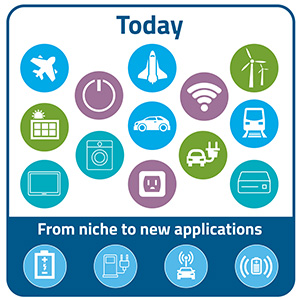
Moore’s Law has been the center of the semiconductor universe, dominated by a singular focus and a relentless drive to reduce transistor size and integrate more, smaller, faster transistors on each chip at the next manufacturing “node.” More-than-Moore devices now represent a new functional diversification of technologies, where digital electronics meet the analog world. These applications are poised to expand dramatically with the coming of 5G connectivity, the internet of everything, and new applications ranging from autonomous driving to neural sensors. And while manufacturers of these specialty devices still care about size, speed and power, they do not necessarily need all the cutting-edge technology required to create the finest geometries at the most advanced nodes.

Technical Challenges
This is not to say that the technical challenges manufacturers face are any less daunting, but that the requirements can be quite different, often involving unique structures and different materials. In many cases these devices can be fabricated using tools and processes originally developed for older, larger nodes but now selectively enhanced with new technologies and lessons learned at the cutting-edge.
Let’s look at some of the types of chips and circuitry needed to move information between the real and digital worlds and the manufacturing challenges they present.
Sensors and Transducers
Sensors and transducers convert variations in a physical quantity into an electrical signal, or vice versa. The quantities they convert, temperature, pressure, motion, etc., and the signals they generate are typically analog, that is, they vary continuously over a range of values. Sensor technologies are as varied as the quantities they sense. A modern car includes hundreds of sensors monitoring everything from fuel mixture to in-cabin carbon monoxide levels. Accelerometers detect collisions and deploy airbags. Gyros sense changes in direction. Autonomous cars will dramatically increase the number of sensors with their need for detailed environmental awareness. A new generation of sensors for your phone will record a harder-to-hack 3D representation of your fingerprint. Ultra-sensitive microphones will let home automation systems hear whispered commands. Biomedical sensors will monitor your health and maybe even your thoughts.
Many sensors are MEMS (microelectromechanical systems), fabricated using materials and processes similar to those used in semiconductor manufacturing but on a much larger scale. Still, accelerometers and gyros already require dimensional control beyond what we can easily see. The fingerprint sensor and microphone mentioned above use advanced piezoelectric materials that require new processes and materials to be deposited and etched.

Analog and Mixed Signal
The electrical signal out of a sensor typically remains analog – a varying voltage or current. It may need to be amplified, filtered, or otherwise conditioned. This is the job of analog circuitry. Analog circuits are also used in the other direction, as when they amplify audio signals sent to the speaker in a sound system. Another important analog application is the radio frequency signaling used for wireless communication in WiFi, Bluetooth, and cellular networks and for radar in assisted driving systems.
Analog circuits do not necessarily benefit from small geometries, and they can be very challenging to design and produce, since slight variations in one component can have unexpected consequences throughout the circuit.
Mixed signal circuits include both digital and analog components. Devices that convert analog signals to digital, and vice versa, are necessarily mixed signal. This type of circuit is expanding rapidly as manufacturers seek to combine more functions with fewer chips. Manufacturing processes that create different types of transistors on the same chip, bipolar for analog, CMOS for digital and DMOS for power, have very different requirements from the CMOS processes that dominate in digital circuitry. Mixed signal circuits are now transitioning from 200 mm to 300 mm wafers, making them excellent candidates for bridge tools designed when the same transition was made at the leading-edge years ago.
Power
Though not part of the signal conversion train, providing and managing power is an essential requirement for every device. Applications range from high-power devices for wind turbines and high-speed trains for example, to fast-charging/high-power devices as seen in electric cars. Fast-charging and power management are also key requirements in small mobile and handheld devices. All of these use different technologies. Some include thin vertical structures with large lateral dimensions. Some are based on wide band-gap semiconductors like gallium nitride and silicon carbide.
Another article in this blog (“New Life for Older Equipment”) describes the adaptation of Lam’s Versys® Kiyo45™, originally introduced 15 years ago as a 200 to 300 mm bridge tool, to etch GaN and AlGaN on a silicon wafer substrate in the fabrication of high electron mobility transistors for a new power device.

Photonics and Optoelectronics
As the demand for data increases and the networks begin the transition to 5G photonic and optoelectronic circuits will increase in demand. These devices convert between light and electrical signals. Lasers and light emitting diodes (LEDs) may be used for lighting or signaling. Micro-LED phone displays are in development. Photodetectors receive signals and capture images. Electro-optical modulators can modulate the phase, frequency, amplitude or polarization of light signals. Opto-isolators protect electronic circuits from stray voltages and interference. Waveguides route signals within a chip.
Active photonic and optoelectronic devices are often built with wide band gap compound semiconductors, while passive components, like waveguides, are usually silicon based. Fabrication processes for these devices require very good cross-wafer uniformity and tight control of optical properties like refractive index.
The rapid proliferation of connected electronic devices in myriad new application segments – portable/wearable, internet-of-things, 5G cellular, cloud storage, self-driving cars, and many more – is creating demand for specialized manufacturing tools. Many of these devices do not need the ultra-small dimensions of advanced nodes and can be built on systems originally introduced at larger, older nodes. But many also require specific modifications or benefit from selective upgrades that incorporate new technologies and lessons learned at the leading edge.